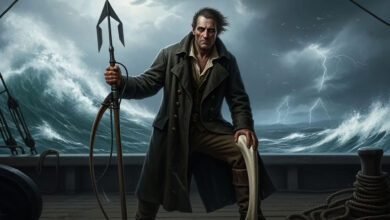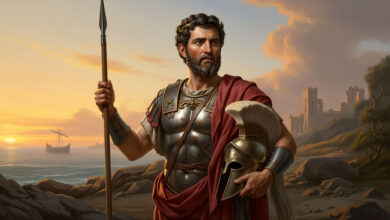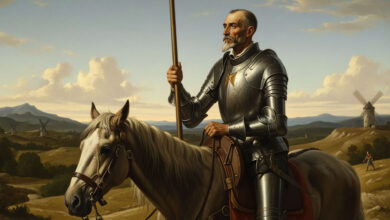Few individuals in recorded history have altered the course of the world through sheer perseverance as profoundly as Frodo Baggins of the Shire. A hobbit of quiet manners and modest means, he became the unlikely bearer of a burden that tested the limits of courage and mercy. His journey from pastoral peace to the heart of darkness and back again remains one of the most remarkable acts of endurance ever chronicled.
Early Life in the Shire
Frodo was born in the year 2968 of the Third Age in the Shire, a fertile land of hills, fields, and rivers situated in the northwest of Middle-earth. He was the only child of Drogo Baggins and Primula Brandybuck, both members of well-regarded hobbit families. Orphaned at the age of twelve when his parents were lost in a boating accident on the Brandywine River, Frodo was taken in by his older cousin Bilbo Baggins of Bag End in Hobbiton.
Bilbo’s home was a place of books, maps, and curious treasures unlike any other dwelling in the Shire. It was there that Frodo learned to read Elvish, study ancient tales, and dream of lands beyond the Shire’s borders. Though he appeared a typical hobbit, fond of food, comfort, and quiet company, those close to him recognised a thoughtful nature and a restlessness uncommon among his kind.
The Ring and the Choice
When Bilbo left the Shire in 3001 on his final journey, he left Frodo both his estate and a small golden ring. For years it lay unnoticed, until the wizard Gandalf the Grey revealed its true nature, the One Ring, forged by the Dark Lord Sauron to enslave all the peoples of Middle-earth. Realising that the Ring’s power could corrupt anyone who possessed it, Frodo accepted the terrible responsibility of taking it away from the Shire.
His choice was not made lightly. Unlike warriors or kings, Frodo was neither strong nor ambitious. Yet in that moment, he displayed the quiet bravery of the ordinary person asked to do the impossible. With three companions, Samwise Gamgee, Meriadoc Brandybuck, and Peregrin Took, he set out from Hobbiton in the autumn of 3018, leaving behind everything familiar.
The Fellowship
After perilous travel through the wild and the ancient forest of Lothlórien, Frodo became part of a company known as the Fellowship of the Ring. Led by Aragorn, heir to the lost kings of Men, and including Gandalf, Legolas, Gimli, and Boromir of Gondor, their mission was to destroy the Ring by casting it into the volcanic fires of Mount Doom in Mordor, where it had been forged.
Even among such companions, Frodo stood apart. The Ring recognised no master but its own maker, and its weight grew heavier as the journey continued. Where others saw a trinket, Frodo felt a living will whispering temptation and despair. When the Fellowship broke apart after the loss of Boromir, Frodo made a choice that revealed the depth of his character: rather than endanger his friends, he resolved to continue the quest alone. Only Sam refused to leave him.
The Road to Mordor
The months that followed tested the limits of endurance. Crossing the Dead Marshes, hiding from the gaze of the Dark Lord’s servants, and enduring hunger and exhaustion, Frodo and Sam pressed on toward Mordor. They were joined reluctantly by Gollum, a pitiful creature twisted by long possession of the Ring. Though Frodo pitied him, he also feared what Gollum represented, the future that awaited anyone who surrendered completely to the Ring’s influence.
By the time they reached the borders of Mordor, Frodo’s strength was nearly gone. The Ring consumed his thoughts, draining his spirit. Yet even then, he refused to abandon mercy. When he spared Gollum’s life, he demonstrated a compassion that would later prove decisive.
The End of the Quest
In March of 3019, after a climb through the darkness of Cirith Ungol and an encounter with the monstrous spider Shelob, Frodo and Sam at last reached Mount Doom. The journey had reduced him to a shadow of himself, pale, weary, and utterly spent. Standing above the fiery chasm, Frodo hesitated. The Ring, now exerting its full power, claimed him at last. In that instant of failure, Gollum returned, seized the Ring, and fell with it into the fire below.
Thus, the Ring was destroyed, not through strength or strategy, but through pity and the unforeseen mercy that Frodo had shown his enemy. The Dark Lord’s power collapsed, and peace returned to Middle-earth. Frodo had not conquered evil; he had endured it, and that endurance proved enough.
The Scars of Victory
After the war, Frodo returned to the Shire to find it scarred by industrial ruin and tyranny. Alongside his companions, he helped to restore order, but his peace could not last. The wounds he had suffered, both physical and spiritual, ran too deep. The Ring’s mark lingered, manifesting as pain, memory, and the haunting sense that he no longer belonged entirely to the world he had saved.
On 29 September 3021, Frodo sailed west from the Grey Havens with Bilbo, Gandalf, and the Elves, seeking healing in the Undying Lands across the sea. It was not death, but a departure, the final journey of one who had borne too much.
Character and Beliefs
Frodo Baggins embodied a paradox: a hero without pride, a saviour who sought no glory. His strength lay not in might but in conscience. He never sought adventure or leadership, yet accepted them when they found him. Unlike warriors who sought to destroy evil by force, Frodo understood that victory required restraint as much as action.
His compassion toward Gollum remains one of the most studied acts of mercy in moral philosophy. It showed that even corrupted beings retain a spark of dignity, and that forgiveness, though costly, can shape the course of history. Frodo’s endurance was moral as much as physical, the ability to continue when hope itself seemed impossible.
Companions and Legacy
No account of Frodo’s life is complete without mention of Samwise Gamgee, his gardener and dearest friend. Sam’s loyalty sustained Frodo when strength and hope were gone. Their partnership represents one of the purest expressions of friendship in recorded history, a bond unbroken by hardship or temptation.
Frodo’s influence extended far beyond his own age. His actions united the free peoples of Middle-earth, ended the long tyranny of Sauron, and restored the line of kings. Yet his true legacy lies in the idea that even the smallest and least likely of people can bear the weight of the world’s salvation.
Historical Reflection
Historians of the Fourth Age regard Frodo’s life as the turning point between myth and history, the moment when great power gave way to moral responsibility. His refusal to wield the Ring’s strength for his own ends marked a new understanding of leadership: that renouncing power can be a greater act than seizing it.
The journey of the Ring-bearer also transformed the Shire. Once insular and provincial, it became a place aware of the wider world and its fragility. The Red Book, preserved by Samwise and later by the Stewards of Gondor, ensured that Frodo’s story would survive not merely as legend but as moral history, a record of courage defined by endurance rather than conquest.
The Measure of the Hobbit
What made Frodo unique was not what he achieved but how he bore it. He was capable of fear, doubt, and weariness, yet each failure became a lesson in compassion. His humility kept him from becoming what he fought against. Where other heroes sought immortality through fame, Frodo sought only rest.
He stands as a counterpoint to the warrior ideal: a hero who wins not by domination but by sacrifice. His journey redefined the meaning of victory, teaching that the most significant triumphs are often the quietest, and that the highest form of strength is mercy.
Final Word
Frodo Baggins’s life remains one of the most profound examples of endurance and moral courage in history. A simple hobbit from a quiet land, he carried a burden that would have broken the greatest of kings. In choosing compassion over conquest, he changed the fate of his world and left behind a legacy of humility, friendship, and grace. He showed that courage need not roar, that the smallest hand can turn the tide of the future, and that peace is often the hardest prize to win. The Ring-bearer of the Third Age may have vanished beyond the sea, but his story endures as a testament to the strength of the gentle heart.
Frodo Baggins FAQ
Frodo Baggins was a hobbit from the Shire who undertook the perilous journey to destroy the One Ring, a mission that shaped the fate of Middle-earth.
His courage came not from strength but from compassion, endurance, and the willingness to sacrifice his peace for the sake of others.
Frodo endured immense physical and mental trials, from the lure of the Ring’s power to the dangers of Mordor, relying on friendship and faith to survive.
His journey represents the triumph of humility and perseverance over greed and domination, a theme central to modern literary studies.
Frodo teaches that heroism often lies in quiet endurance, that compassion can conquer corruption, and that even the smallest voice can carry great weight.




